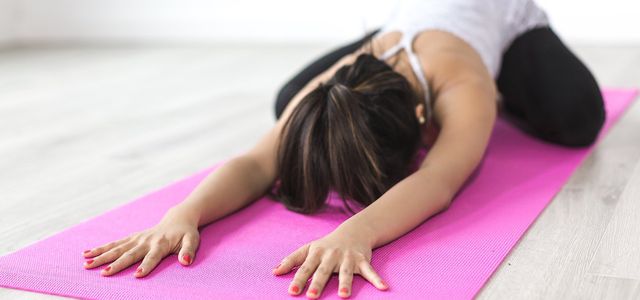
Yin Yoga is a slow style of yoga in which the poses are held for several minutes. In doing so, you can thoroughly stretch your connective tissue and find a calm mind. We will introduce you to the style in detail.
Yin Yoga: Philosophy and Origins

(Photo: CC0 / Pixabay / OpenClipart-Vectors)
The name “Yin Yoga” is derived from the Chinese concept of Yin and yang which plays a role especially in Daoism. This philosophy describes Yin and Yang as opposing forces or principles: While Yin represents the feminine, calm, soft and passive energy, Yang embodies the masculine, hard, dynamic and active counterpart. In anatomical terms, Yang stands for the muscles and Yin for the connective tissue such as tendons and ligaments.
The Taoist yoga teacher applied this principle Paulie Zink In the late 1970s he first took up yoga: With Yin Yoga, he developed a yoga style that balances the active, dynamic and physically demanding yoga styles. Yoga teachers Paul Grilley and Sarah Powers then continued to shape Yin Yoga and mature it into the style it is known as today.
Yin Yoga has always been characterized primarily by a calm, slow practice in which the poses are held for a long time. This is basically not a reinvention but a crucial part of traditional yoga practice Hatha yoga and Daoist Yoga. For example, in the Iyengar yoga Poses held for minutes.
The practice in Yin Yoga: calm, passive, meditative



(Photo: CC0 / Pixabay / StockSnap)
Yin Yoga is a calm, passive yoga style, in which the asanas (postures) are mostly performed lying down and sitting, and between held for three and seven minutes will. In addition, a neutral lying position is often integrated between the asanas for harmonization.
Includes a typical yin yoga class Bends forward, slight back bends, hip openers and twisting postures. Some of the asanas are also known from other yoga styles, for example the Sun salutation or the shoulder stand. To differentiate, many of the poses in Yin Yoga have a different name: The sprinter is called a dragon, the dove is called a swan instead. This is to prevent students from practicing the pose as they know it from other yoga styles.
Because physically the asanas look similar or the same, but the intention and the inner posture are different: In Yin Yoga, the poses are usually performed with little to no muscle exertion. Instead, you want to completely let go of all unneeded muscles, creating space for you calm, meditative state arises.
In contrast to restorative yoga, Yin yoga is less about relaxation than about deep-lying connective tissue and muscles to stretch more intensely with the help of gravity.
Often yin yoga lessons are also short meditation opened and ended. Singing bowls are sometimes used or the om-Mantra spoken.
This is how Yin Yoga affects the body and mind



(Photo: CC0 / Pixabay / jeviniya)
Since our fast-paced everyday life is often characterized by stress and most sports by tension, according to the Chinese philosophy, for many people the yang is the more present energy. Yin Yoga is said to serve the opposite forces of Yin and Yang back into balance to bring – on a physical and mental level.
On physical level will the Thoroughly stretch muscles, ligaments, and tendons. By holding the asanas for a long time, the deep-lying connective tissue is also reached and glued fasciae are loosened and “torn open”. Fascia is the connective tissue that surrounds all muscles, bones and organs like a large network and thus holds the body together internally.
So Yin Yoga helps against muscular Tension and takes care of more Freedom of movement, smoother joints and more flexible connective tissue and muscles. In contrast to other yoga styles, in which the back is deliberately kept straight, in Yin Yoga it is always rounded. By stretching the back muscles, the practice can therefore do well Back pain help.
On psychic level Yin Yoga works in a similar way to silent meditations: During the long postures, the mind comes to rest and you focus more attention on yourself and your body. This is supposed to lead to a more balanced mind and inner calm to lead. Yin Yoga is therefore suitable Reduce stress and prevent. This also confirms one Study from 2017, in which the test subjects: inside a five-week program with Yin Yoga and Mindfulness exercises participated.
By doing yin yoga psychological problems like Anxiety, Stress and depression counteracts, can with the yoga style according to one Study from 2018 Even non-communicable diseases like heart disease can be prevented.
Yin Yoga: Who is the Yoga Style Suitable for?



(Photo: CC0 / Pixabay / SaraJobling)
Yin yoga is a beginner-friendly yoga style, which in principle is suitable for everyone: n. Anyone struggling with a busy schedule, a hectic everyday life or tension can find the necessary balance through regular Yin Yoga.
Yin Yoga is particularly recommended for elderly and for rehabilitation after illnesses and accidents. However, if you have a physical condition such as a ruptured miniscus or a herniated disc, you should seek medical advice in advance as to which postures are suitable for you.
Even if you already have another more challenging yoga style such as Ashtanga yoga, Jivamukti Yoga or Bikram yoga If you practice, an occasional yin yoga class can be one good addition be. Also to sports like climbing, fitness training, handball or swimming, Yin Yoga can be a suitable counterbalance – also ideal for stretching after training.
Read more on Techzle.com:
- Learning meditation: tips for beginners
- Yoga accessories: This is what you need for training
- 4 simple relaxation exercises